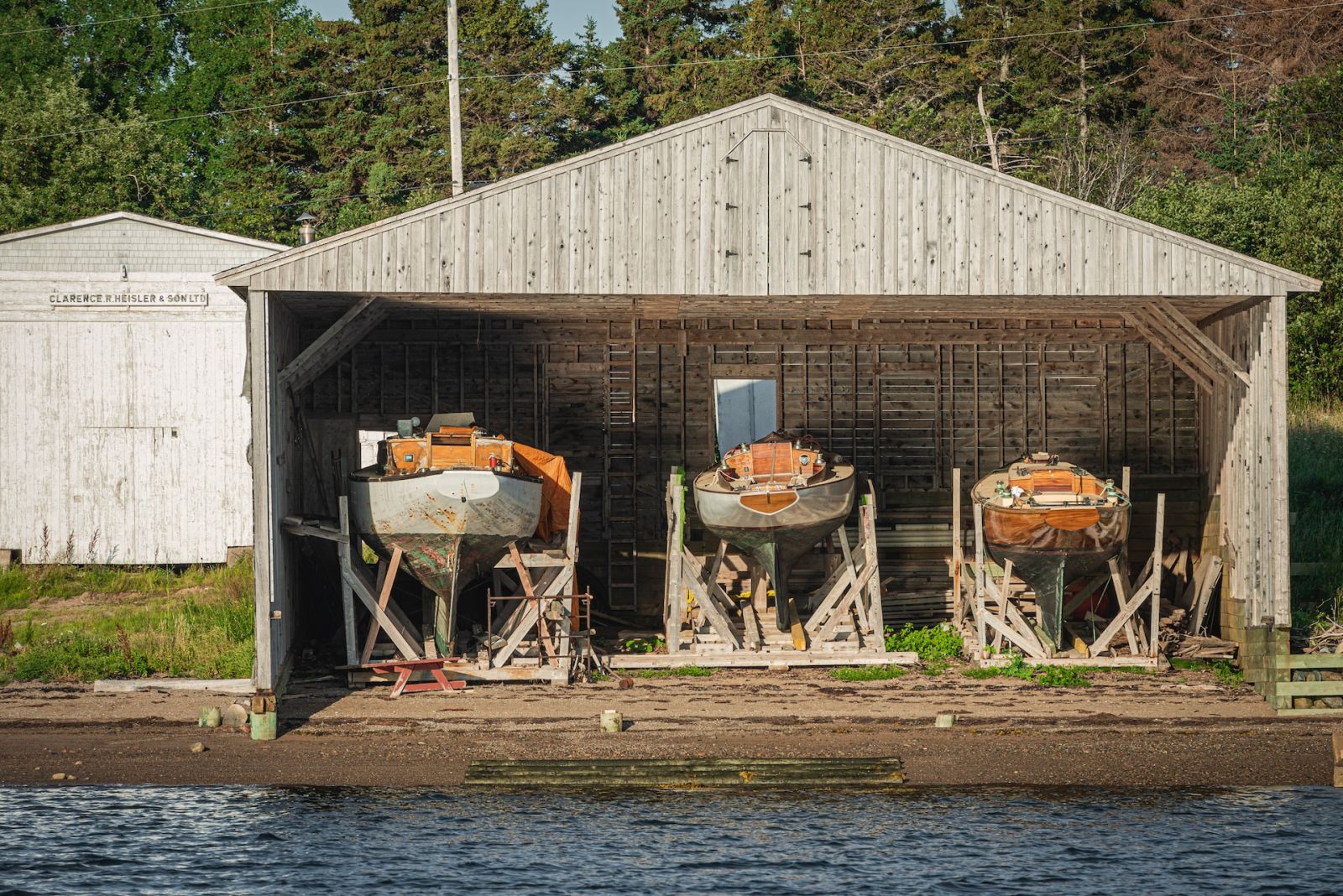How Long Does It Take to Build a Sailboat? (DIY vs. Shipyard)
You may be thinking of building a sailboat by yourself, but shipyards have expert knowledge, established processes, and a skilled workforce, which contribute greatly to efficiency and ultimately lead to a more streamlined building process. The time it takes to finish a project depends on the complexity of the design, your woodworking experience, and the availability of materials and tools.
For DIY enthusiasts, constructing a small sailboat like a dinghy can take anywhere from 2 to 6 months. More elaborate designs, like multi-hull sailboats with intricate rigging, may take up to 2–5 years to complete. On the other hand, hiring a professional shipyard can cut the time by half.
The process of building a sailboat involves more than just cutting and fitting wooden components. Below, you'll find an overview of the different materials and woodworking skills that you need in order to build a sailboat on your own.
Summary
- Professionals in a shipyard have access to great resources, equipment, and expertise that, when combined with the shipyard's ability to work on multiple boats simultaneously, can shorten the timeline considerably.
- Production boats benefit from economies of scale and years of design refinement that may not be present in a DIY sailboat.
- Investing in a shipyard-built sailboat ensures that your boat is built according to industry standards.
- The most common materials for building a sailboat are wood, fiberglass, and aluminum.

On this page:
Estimated Time to Build a Sailboat
It can take significantly longer to build a sailboat by DIY than through a shipyard. This is because building a sailboat requires a lot of specialized knowledge and skills, as well as access to specialized tools and materials. While building a sailboat by DIY can be a rewarding experience, it can also be a challenging and time-consuming process that requires a lot of patience and dedication.
On the other hand, building a sailboat through a shipyard can be a more efficient process, as shipyards have the expertise, resources, and equipment necessary to build sailboats quickly and efficiently. However, building a sailboat through a shipyard can also be more expensive than building one by DIY.
| Types of Sailboats | Time to Build DIY | Time to Build by a Shipyard |
|---|---|---|
| Dinghy | 2-6 months | 1-3 months |
| Catboat | 6 months - 1 year | 3-6 months |
| Sloop | 1-3 years | 6 months - 2 years |
| Ketch | 2-5 years | 1-3 years |
| Schooner | 3-7 years | 2-5 years |
| Trimaran | 2-5 years | 1-3 years |
| Catamaran | 2-5 years | 1-3 years |
-
Dinghy: A dinghy is a small, lightweight sailboat that is typically used for day sailing or as a tender for a larger boat. Dinghies are usually less than 12 feet in length and can be sailed by one or two people.
-
Catboat: A catboat is a sailboat with a single sail and a mast located near the front of the boat. Catboats are typically used for day sailing or fishing and are known for their stability and simplicity.
-
Sloop: A sloop is a sailboat with two sails: a mainsail and a jib. Sloops are one of the most popular sailboat designs and are used for a wide range of activities, from day sailing to racing.
-
Ketch: A ketch is a sailboat with two masts: a taller main mast and a shorter mizzen mast located near the stern. Ketches are known for their versatility and are often used for long-distance cruising.
-
Schooner: A schooner is a sailboat with two or more masts, with the forward mast being shorter than the aft mast. Schooners are often used for racing or as luxury yachts.
-
Trimaran: A trimaran is a sailboat with three hulls. Trimarans are known for their speed and stability and are often used for racing or long-distance cruising.
-
Catamaran: A catamaran is a sailboat with two hulls. Catamarans are known for their speed and stability and are often used for racing or as luxury yachts.
To learn more about the different types of sailboats, here's our comprehensive article featuring the details of each type.
| Size of Sailboat | Time to Build DIY | Time to Build by a Shipyard |
|---|---|---|
| Small sailboats (less than 20 feet) | 2-6 months | 1-3 months |
| Medium sailboats (20-40 feet) | 1-3 years | 6 months - 2 years |
| Large sailboats (over 40 feet) | 2-5 years | 1-3 years |
DIY vs Shipyard Sailboat Building
| DIY Building a Sailboat | Shipyard Building a Sailboat |
|---|---|
| - more cost-effective | - upfront cost is higher |
| - save on labor costs | - lower maintenance costs |
| - time-consuming | - complete within a specified timeframe |
| - may match the quality of a shipyard-built boat if you take your time | - experienced craftsmen and standardized processes |
| - additional costs for tools, paint, and extra materials | - access to better materials and resources |
Cost differences of DIY and shipyard methods
DIY boat-building can be more cost-effective, particularly if you have access to the tools and materials needed for the project. Building a boat on your own can allow you to save on labor costs, which are often a significant portion of the overall expense of shipyard boat construction. However, be sure to account for additional costs such as tools, paint, and extra materials that may not be included in a DIY kit.
On the other side, shipyards offer greater convenience, expertise, and potentially lower material costs due to their bulk purchasing power. While the upfront cost of having your boat built by a professional may be higher than a DIY project, it can be more reliable and may lead to lower maintenance costs later on.
Time differences of DIY and shipyard methods
Building a sailboat on your own is a time-consuming process, involving hundreds to thousands of hours, depending on your skills and the complexity of the boat design. DIY enthusiasts should be prepared to spend considerably more time on their sailing projects than they initially anticipate.
In contrast, shipyards and professional boat builders are much faster at constructing boats due to their established infrastructure and experienced workforce. These professionals can usually complete a boat-building project within a specified timeframe, enabling you to get out on the water sooner than with a DIY build.
Quality and durability comparisons
The quality and durability of a sailboat primarily depend on the skills, experience, and attention to detail of the builder. A DIY boat may match the quality of a shipyard-built vessel if you take your time, follow instructions carefully, and use the recommended materials. On the other hand, amateur builders might make mistakes or use substandard materials, leading to a less durable and potentially unsafe boat.
Shipyards have the advantage of experienced craftsmen and standardized processes, which often result in a higher degree of quality and durability. Additionally, professional boat builders often have access to better materials and resources, further improving the vessel's long-term stability and performance. However, this does not mean that all shipyard-built boats are flawless. As with any product, the overall quality depends on the specific shipyard and its commitment to excellence.

DIY Sailboat Building
Design and planning involves creating a detailed plan
The first step in building a sailboat is to choose a design that meets your needs and skill level. This involves researching different sailboat designs, taking into account factors such as size, stability, and performance. Once you have chosen a design, you will need to create a detailed plan that includes all the necessary materials, tools, and techniques required to build the boat. This step can take several weeks or months, depending on the complexity of the design and the amount of research and planning required.
Lofting and cutting stage of DIY sailboat
Lofting involves transferring the design from the plans to the plywood sheets, while cutting involves using a circular saw and jigsaw to cut the plywood to the correct size and shape. This step can take several weeks, depending on the size of the boat and the complexity of the design.
Lofting is the process of creating full-sized plans of the boat on a large flat surface, such as a lofting floor. This allows the builder to transfer the design to the wood and ensure that all the parts fit together properly. Once the plans have been lofted, the next step is to cut the various parts of the boat from the wood using a variety of tools, such as saws, chisels, and planes.
Assembly phase involves gluing the plywood panels together
Assemble the cut parts together using a variety of techniques, such as joinery, fastening, and rigging. This requires careful attention to detail to ensure that the boat is strong, seaworthy, and able to sail effectively. Assembly involves gluing the plywood panels together with epoxy and fiberglass to create the hull, deck, and interior of the boat. This step can take several months, depending on the size of the boat and the amount of detail work involved.
Finishing step to build a boat by yourself
Finish the boat by sanding, painting, and varnishing the various parts of the boat. This not only makes the boat look beautiful, but also helps protect it from the elements. This involves sanding the boat to create a smooth surface, applying paint or varnish, and installing hardware and fittings. This step can take several weeks or months, depending on the complexity of the finishing work and the number of fittings and hardware required.

Required skills to build a sailboat
Building a sailboat is not just about cutting and fitting wooden parts; it also involves working with different materials, understanding sailboat design, and mastering techniques like fiberglassing and rigging. It's important to be patient and willing to learn, as you will likely encounter challenges along the way. Don't hesitate to seek help from experienced builders or online forums if you need guidance.
-
Reading and interpreting plans: Building a sailboat requires the ability to read and interpret detailed plans and drawings. This includes understanding the various parts of the boat and how they fit together.
-
Measuring and cutting wood: Building a sailboat requires precise measurements and accurate cuts. This includes cutting wood to the correct size and shape, as well as making angled cuts for joints and fittings.
-
Joinery: Joinery is the process of connecting two pieces of wood together. Building a sailboat requires a variety of joinery techniques, including mortise and tenon joints, dovetail joints, and scarf joints.
-
Sanding and finishing: Once the boat is assembled, it must be sanded and finished to create a smooth, polished surface. This includes sanding the wood to remove rough spots and applying a finish such as varnish or paint.
-
Knowledge of boatbuilding materials: In addition to woodworking skills, building a sailboat requires knowledge of boatbuilding materials such as marine-grade plywood, epoxy, and fiberglass.
Materials and equipment for a DIY sailboat
The cost of building a sailboat can vary depending on the size and complexity of the boat, as well as the quality of the materials and tools you use. Expect to spend $300–600 per foot when building a quality 16–20-foot daysailer. Basic sailboat kits may not include all the materials and equipment needed to complete the project, so you should budget for additional expenses like sails, rigging, and hardware.

The most common core materials are wood, fiberglass, and aluminum. Each material brings unique characteristics to your sailboat.
-
Wood is a traditional and classic choice, providing natural beauty and ease of access. It's an ideal material for DIY enthusiasts because of its workability and affordability. However, wood requires periodic maintenance to prevent rot and decay.
-
Fiberglass is another popular choice due to its low-maintenance properties, long-lasting durability, and relatively low cost. It's lightweight and strong, which is why many modern sailboats are made of fiberglass. Keep in mind that working with fiberglass might require specific tools and skills.
-
Aluminum is a more advanced but still popular material, particularly for larger sailboats. Aluminum boats are known for their resistance to corrosion, low weight-to-strength ratio, and long service life. Building an aluminum sailboat requires more advanced welding and metalworking skills.
Building techniques for constructing a sailboat
The right technique depends on factors like your boat's design, the core material, and your level of experience.
-
Stitch-and-glue is a relatively simple construction method that involves cutting plywood panels to the desired shape, "stitching" them together using wire, and then bonding the seams with epoxy and fiberglass tape. This technique is often used for smaller, wooden sailboats.
-
Strip planking involves attaching narrow strips of wood edge-to-edge on the boat's frame, then overlaying the wooden structure with fiberglass for strength and durability. This method works best for more complex hull shapes and generally requires more time and skill.
-
Frame-and-panel construction is typically used for larger sailboats with intricate designs. In this method, you'll create a frame first, and then attach pre-cut panels (usually made of aluminum or fiberglass) to the frame. This technique requires more advanced metalworking skills and specialized tools for cutting and shaping the panels.

Shipyard-Built Sailboats
Process executed professionally and on time
At the shipyard, the sailboat goes through several stages, which include design, hull construction, deck fitting, and interior installation.
- The initial stage typically involves drafting the boat's design based on your preferences and the naval architect's expertise.
- Once the design is finalized, the shipyard will proceed with building the hull, often using modern materials like fiberglass or steel.
- After the hull is completed, the shipyard will work on fitting the deck and installing the mast, rigging, sails, hardware, and other equipment.
- The interior installation follows suit, with the shipyard ensuring that the plumbing, electrical systems, and woodwork are all done according to the design specifications and safety standards.
- Once the boat is complete, the shipyard will typically conduct sea trials to ensure that the boat is seaworthy and functioning properly.
- Once the boat has passed sea trials, it will be delivered to the owner.
The timeframe for building a sailboat at a shipyard
Building a sailboat at a shipyard can take anywhere from a month to three years. A simple, smaller sailboat might take three months to complete, while a larger or more complex boat may require over a year. The extent of craftsmanship and design details also play a significant role in determining the overall duration of the project.
Did you find the answer to your specific question?
👍 0 👎 0



Leave a comment